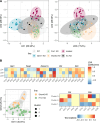Deciphering autism heterogeneity: a molecular stratification approach in four mouse models
- PMID: 39366951
- PMCID: PMC11452541
- DOI: 10.1038/s41398-024-03113-5
Deciphering autism heterogeneity: a molecular stratification approach in four mouse models
Abstract
Autism spectrum disorder (ASD) is a complex neurodevelopmental condition characterized by impairments in social interaction and communication, as well as restrained or stereotyped behaviors. The inherent heterogeneity within the autism spectrum poses challenges for developing effective pharmacological treatments targeting core features. Successful clinical trials require the identification of robust markers to enable patient stratification. In this study, we identified molecular markers within the oxytocin and immediate early gene families across five interconnected brain structures of the social circuit. We used wild-type and four heterogeneous mouse models, each exhibiting unique autism-like behaviors modeling the autism spectrum. While dysregulations in the oxytocin family were model-specific, immediate early genes displayed widespread alterations, reflecting global changes across the four models. Through integrative analysis, we identified Egr1, Foxp1, Homer1a, Oxt, and Oxtr as five robust and discriminant molecular markers that allowed the successful stratification of the four models. Importantly, our stratification demonstrated predictive values when challenged with a fifth mouse model or identifying subgroups of mice potentially responsive to oxytocin treatment. Beyond providing insights into oxytocin and immediate early gene mRNA dynamics, this proof-of-concept study represents a significant step toward the potential stratification of individuals with ASD. This work has implications for the success of clinical trials and the development of personalized medicine in autism.
© 2024. The Author(s).
Conflict of interest statement
The authors declare no competing interests.
Figures




Similar articles
-
The oxytocin receptor gene polymorphism rs2268491 and serum oxytocin alterations are indicative of autism spectrum disorder: A case-control paediatric study in Iraq with personalized medicine implications.PLoS One. 2022 Mar 22;17(3):e0265217. doi: 10.1371/journal.pone.0265217. eCollection 2022. PLoS One. 2022. PMID: 35316293 Free PMC article.
-
Intranasal oxytocin administration ameliorates social behavioral deficits in a POGZWT/Q1038R mouse model of autism spectrum disorder.Mol Brain. 2021 Mar 16;14(1):56. doi: 10.1186/s13041-021-00769-8. Mol Brain. 2021. PMID: 33726803 Free PMC article.
-
Targeting oxytocin receptor (Oxtr)-expressing neurons in the lateral septum to restore social novelty in autism spectrum disorder mouse models.Sci Rep. 2020 Dec 17;10(1):22173. doi: 10.1038/s41598-020-79109-0. Sci Rep. 2020. PMID: 33335150 Free PMC article.
-
Oxytocin receptor and Mecp2 308/Y knockout mice exhibit altered expression of autism-related social behaviors.Physiol Behav. 2012 Dec 5;107(5):641-8. doi: 10.1016/j.physbeh.2012.02.024. Epub 2012 Mar 3. Physiol Behav. 2012. PMID: 22406388 Free PMC article. Review.
-
Oxytocin and Animal Models for Autism Spectrum Disorder.Curr Top Behav Neurosci. 2018;35:213-237. doi: 10.1007/7854_2017_15. Curr Top Behav Neurosci. 2018. PMID: 28864977 Review.
Cited by
-
The Evolving Landscape of Functional Models of Autism Spectrum Disorder.Cells. 2025 Jun 16;14(12):908. doi: 10.3390/cells14120908. Cells. 2025. PMID: 40558535 Free PMC article. Review.
References
-
- American Psychiatric Association. Diagnostic and statistical manual of mental disorders. 5th ed. American Psychiatric Association; 2013.
-
- McCracken JT, McGough J, Shah B, Cronin P, Hong D, Aman MG, et al. Risperidone in children with autism and serious behavioral problems. N Engl J Med. 2002;347:314–21. - PubMed
MeSH terms
Substances
Grants and funding
- 851231/EC | EU Framework Programme for Research and Innovation H2020 | H2020 Priority Excellent Science | H2020 European Research Council (H2020 Excellent Science - European Research Council)
- ANR-10-LABX-53-01/Agence Nationale de la Recherche (French National Research Agency)
- ANR-10-LABX-53-01/Agence Nationale de la Recherche (French National Research Agency)
- ANR-10-LABX-53-01/Agence Nationale de la Recherche (French National Research Agency)
LinkOut - more resources
Full Text Sources
Medical
Molecular Biology Databases

